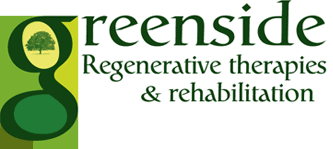Our prices
Initial consult - £300
Diagnostics - £1200
Initial enquiries and what to expect
- Your initial enquiry may be by phoning in to the practice to speak with the regenerative medicine team, emailing a query or by using our ‘pet owner enquiry’ section on this website.
- A member of the team will contact you to discuss your pet, help liaise with your primary practice and book an appointment with one of the regenerative medicine and rehabilitation vets here at Greenside.
- We do require our website referral form to be completed by your primary care vet, and clinical history and relevant diagnostic test results to be shared with us.
- We will keep your primary care vet informed and updated with detailed referral reports.
Consult & Diagnostics
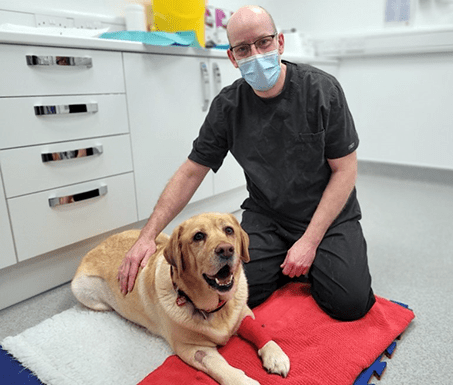
- If your pet has any allergies – medications or food, please let us know. If this is the case, please bring some of their normal food to eat post operatively.
- Admissions usually takes around 15 minutes to discuss the treatment plans and sign a consent form. Please bring along insurance forms if not already provided. Please provide the best phone number to call you on. We will need to know what medications your pet is on and when they were last given.
- The vet will perform a clinical exam and measurements will be taken before any treatment is started. This may include force plate analysis, stance analysis and goniometry. This allows us to regularly repeat these measurements so we can monitor how our patients are responding to treatment.
- X-rays and musculoskeletal ultrasound scans are performed under sedation or general anaesthetic so that we can obtain a complete diagnosis. This is a very thorough process; so please be aware that we may be giving you more information than you were aware of, following our diagnosis.
- The vet will discuss the day’s findings with you after we have performed all the diagnostics; this tends to be around midday. We will then arrange a discharge time for you to collect your pet. This is usually between 2-5pm.
- One of the nurses or patient care assistants will discharge your pet. You will be provided with any required medications/food and an aftercare sheet, with their medications/exercise/appointments/post operative care written down.
Fat harvest
- The fat harvest can be completed on the same day as diagnostics, under the same anaesthetic. We would likely do a discharge closer to 4pm. If you would like to have the fat harvest performed on a different day, then we would admit your pet for an anaesthetic to harvest the fat. This is generally a quick procedure.
- For the fat harvest to be performed on the same day it would be discussed in advance or on the day after diagnostics, which would require owner consent at the time to then proceed.
- For a fat harvest we shave the fur mid abdomen, and the neck for a blood sample required for the culturing of stem cells. The fat is taken from a small incision and is sutured up with internal sutures, which will dissolve over time. The wound will take around 10-14 days to heal.
- During the healing process your pet will be on 3 x 10-minute lead walks. Jumping and stairs are to be avoided the best you can to help the body heal. Don’t bath your pet until the wound is healed.
- It is important to watch for wound interference, so discourage licking or scratching as these can lead to an infection. The wound should be pale in colour with no swelling. Mild bruising can occur. If the wound is swollen, pink or has discharge then there may be an infection where you would need to be seen by your primary care vet. Buster collars and medical suits prevent patient interference and therefore help prevent an infection from occurring.
- The fat is sent to the lab where they culture the stem cells from the sample. This takes a few weeks. On discharge you will be given an appointment for the stem cell implants, which tends to be around 5 weeks later to allow for the culturing of the stem cells.
- At this point we would enrol you onto VetMetrica, this is a questionnaire that allows us to monitor how your pet is getting on. We complete an assessment at consultations and ask that you do the same prior to the appointment. The two set of data combined will allow us to have a better visualisation of how your pet is getting on. This isn’t mandatory but we do appreciate it as we can only get so much information from seeing your pet in a consult. You will be able to provide us with more information by completing the questionnaire on things like your pet’s mood, pain and comfort at home for example, which will then allow us to have a better understanding of your pet’s overall health and their quality of life.
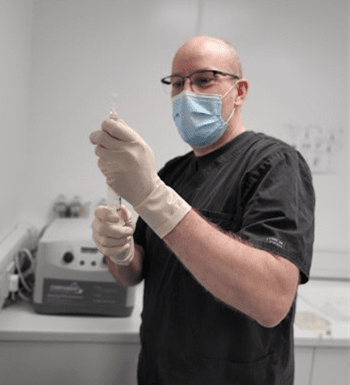 1st stem cell implants
1st stem cell implants
- Admit for general anaesthetic, same process as at diagnostics. Usually, an anaesthetic is used, over sedation as we tend to treat quite a lot of areas and sedation only provides a small time frame where the pet is sleepy enough.
- For the stem cell implants we shave over every joint or muscle/tendon that we require to implant with stem cells. Therefore, your pet will go home with shaved patches, these will grow back. We do this to ensure the procedure is sterile. We place a needle into the area to remove any joint fluid and then inject the stem cells & platelet rich plasma, this is minimally invasive. This is followed by class IV laser therapy on recovery.
- We recommend 5 more laser sessions post implantation; we can perform the laser therapy, which usually takes around 5 minutes per area implanted. However, for those travelling further, we can communicate with the personnel performing the laser therapy for your pet. We can also help you locate laser therapy near you if you require. We recommend a class IV Laser. The laser therapy energises the stem cells and activates the healing response, so they work quicker and additionally, it provides pain relief and reduces inflammation.
- Your pet will go home the same evening usually around 2-5pm. You may notice a different smell from your pet. There is a preservative in stem cells called DMSO which you will be able to smell on your pet’s breath, it passes by the next day and smells a bit like beans.
- After the stem cells are implanted your pet will usually be walking just the same as when they arrived. However, some dogs can have a joint flare, up to 48hrs after injection. Don’t panic if they suddenly seem worse, they will go back to normal shortly. This is caused by inflammation in the joint. This will pass quite quickly, and you should rest your pet and ensure medications are up to date.
- You will be given post operative instructions on discharge. Exercise will be restricted to lead exercise only for the next 6 weeks. Initially it is 10-minute walks, twice daily for two weeks, this can then increase by 10 minutes each walk, each week, until their recheck at 6 weeks.
- During this time, we recommend brain stimulation, as this tires the body out just as well as exercise. Things like snuffle matts, kongs, puzzle feeders, licky mats are great.
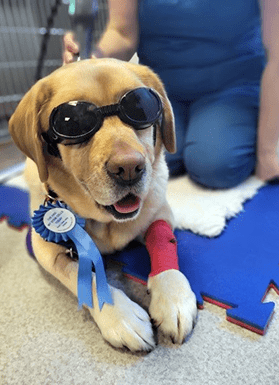 Progression
Progression
Some owners can notice an improvement in the first two weeks following treatment.
At 6 weeks the body is remodelling in response to treatment, so at this stage the patient can appear worse as the body is repairing internally. At 12 weeks post implantation is when you will see the full effect from the stem cell implants.
6 week Recheck
Around 6 weeks post implantation is when we would ask for your pet to come back for a physical recheck, where we will also recheck their measurements. For those living further away this can be done over the telephone, however it is less preferred as we can’t physically check how your pet is getting on.
This appointment will usually take around 30 minutes.
2nd implants – 12 weeks
- You will be advised at diagnostics if your pet requires a second treatment of stem cells. This is determined depending on the severity of each condition. Therefore, we’re not implanting every area again; it will only be the areas that need it. We may also repeat musculoskeletal scans depending on the case, so that we can check on the healing tendons/muscles and treat again if required. The reason we top up with more stem cells 12 weeks later is because the pet will get a better longevity out of the treatment before we may have to top them up with more stem cells, which can be around 18 months/two years later, but is case dependant. The conditions we treat such as osteoarthritis are degenerative conditions, we cannot cure, but we can slow down and reverse the process. Therefore, this treatment is repeated throughout the pet's life and is not a one off treatment.
- We would admit your patient for a likely sedation and top up of stem cells, therefore please bring your pet starved. It is often a sedation due to less areas being treated the second time.
- We will repeat stance, force plate analysis and goniometry to see how the patient is responding.
- We will give you a call around lunch time to let you know how your pet is doing and arrange a discharge around 2-5pm.
- We will perform a laser session after stem cell implant, and then no further laser therapy is required.
- Usually exercise is lead walks only, 3 x 10 minute lead walks for 1 week and then return to normal exercise. All of our medications/treatments/exercises are bespoke to the pet and their conditions so this is a guide.
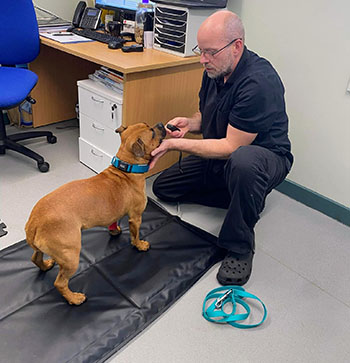 18 week Recheck
18 week Recheck
- Recheck is 6 weeks post 2nd treatment. We repeat all measurements again and see how your pet is doing at home. We will then advise on future exercise and any medications. In some few cases a third treatment may be required where the condition is severely advanced. We can then estimate when you would next be due a check up and expected top up of stem cells.
Recheck Questionnaires
At every visit and consult you will be sent a questionnaire to complete prior to your visit. We check this questionnaire prior to seeing your pet.
The questionnaire asks a range of questions from medications, exercise, mood, lameness, recent vet visits etc. Once we have this information, we can then use the consult time more concisely, as we already have key information answered.
We really appreciate when you complete these questionnaires as it is all vital information that we don’t need to then ask at your consult and then spend that time discussing any questions you may have and updating you on how your pet is doing.
Insurance
We are happy to work with you to see if your insurance company will cover stem cell treatment. We have submitted claims to a vast number of insurance companies so we already have a good understanding of which companies will cover stem cell treatment.
However, we ask that you provide all your insurance details, such as policy number, when it was taken out, percentage co-payments, excesses, exclusions and previous related claimed treatment. This will help us to give you the best advice.
Please remember that it is your responsibility to know your policy details and to let us know when you would like to claim for treatment, although we will do our best to remind you. If not insured / not covered we ask for payment after treatment on the day either by card/cash or bacs. We don’t offer a payment plan.
Regenerative Medicine Fixed Pricing
| Treatment Options | Initial Consultation £300 | Initial Diagnostics £1200 | Surgical fat harvest for stem cell culture (SCs) | PRP implantation into all required areas initial laser session £1150/£1500 | Stem cell implantation with PRP into all the required areas initial laser session £1500 | 6 week check up | 12 check up, follow up diagnostics & second treatment. Single laser session £1000 | 18 week check up £150 |
|---|---|---|---|---|---|---|---|---|
| Platelet rich plasma therapy £3850/£4150 |
||||||||
| Low volume of cultured SCs & PRP £7150 |
£3000 | |||||||
| Moderate volume of cultured SCs & PRP £8150 |
£4000 | |||||||
| High volume of cultured SCs & PRP £9150 |
£5000 |
£1500 when carried out at a seperate date to initial diagnostics as incurs additional GA/sedation fee. If PRP completed on the same day as initial diagnostics then fee is £1150.
Prices may vary based on the number of GA/sedations carried out.
